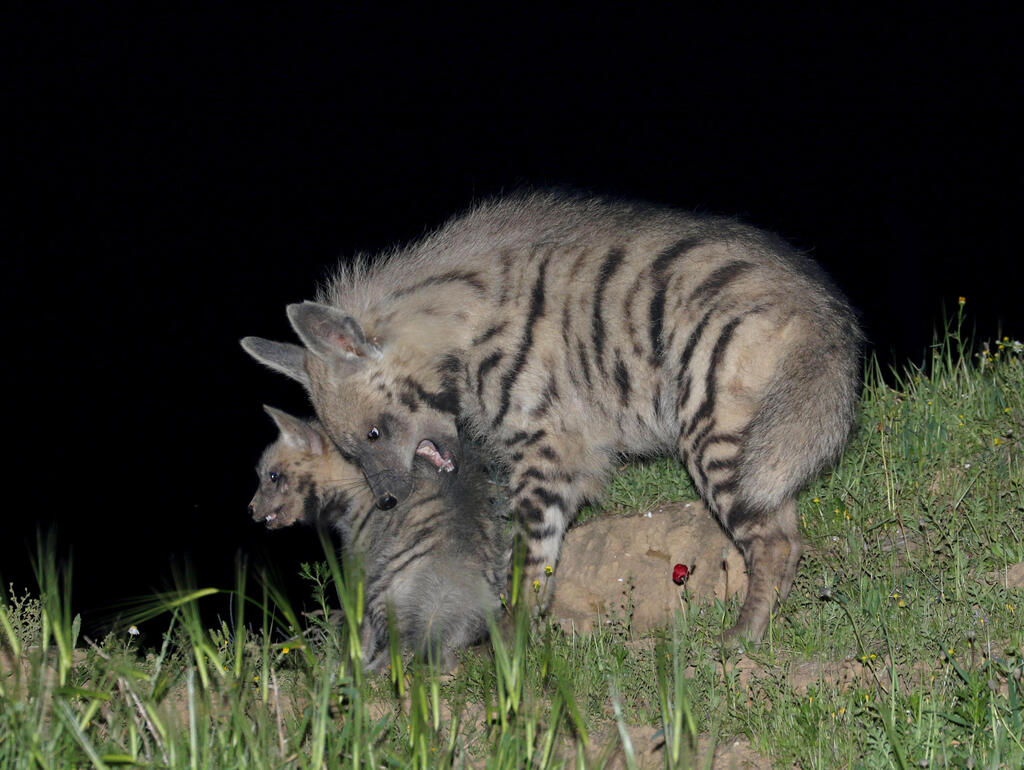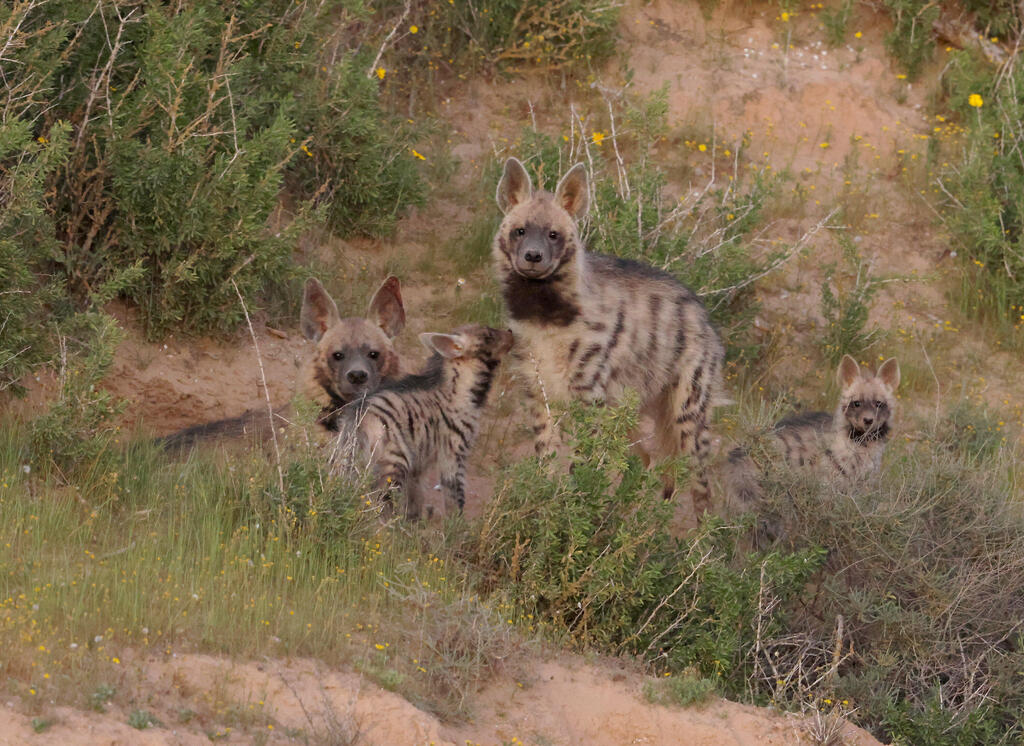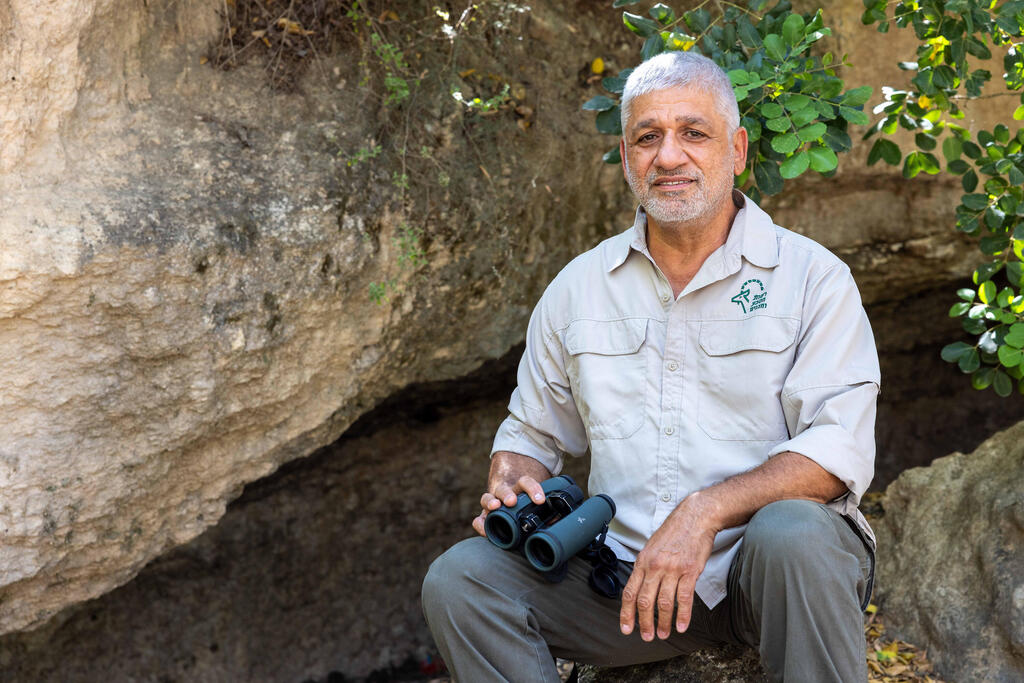Hyenas in the Negev
(Video: Ezra Hadad, Nature and Parks Authority)
Ezra Hadad, a researcher at the Nature and Parks Authority, has always been fascinated by hyenas. He is mainly known for his research on the Eurasian eagle-owl, and conducted an extensive operation to rehabilitate orphaned chicks for adoption by surrogate mothers, after falling in love with the species 40 years ago.
More stories:
But his relationship with hyenas is a love of a different kind. For years, he observed them and studied their behavior from a distance. One of his observations led to a prolonged research project, which was recently published in the journal Animals.
6 View gallery
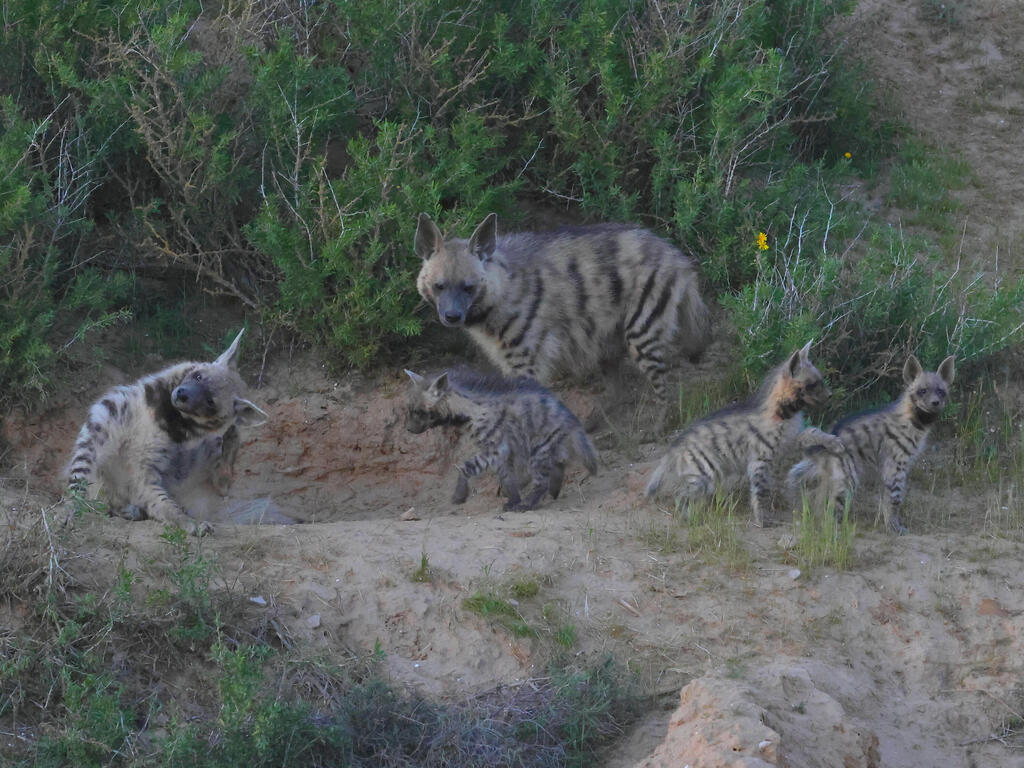

Heynas live in several areas in Israel
(Photo: Ezra Hadad, Nature and Parks Authority)
Hadad placed cameras along a trail to monitor the hyenas in their habitat. "One day, at one of the sites near Modi'in, I saw a hyena mother alone on a rainy day, and suddenly another smaller hyena appeared," he recalls.
"I didn't know who she was. Her cub came out of the burrow for the first time, and they played in the rain like children. She was very attached to the mother, and then I realized she was the one of the mother’s grown-up cubs.”
Hadad enlisted Amir Balaban from the Society for the Protection of Nature and Professor Reuven Yosef from Ben-Gurion University’s campus in Eilat. "Balaban also noticed this phenomenon. We checked the professional literature and found similar behavior documented in the brown hyena, but there was no article on this subject regarding the striped hyena," he said.
The three discovered that among nine female striped hyenas there is a phenomenon of "alloparenting," or care of younger cubs performed by adult cubs from previous broods, and documented 15 events where this behavior occurred.
Alloparenting began when the cubs were about a month old and continued until they reached the age when they would venture out to forage for food with their mothers, around 10-12 months old.
The "helpers," or alternative mothers, perform most of the maternal duties, except nursing, even when the biological mother is present in the vicinity.
6 View gallery
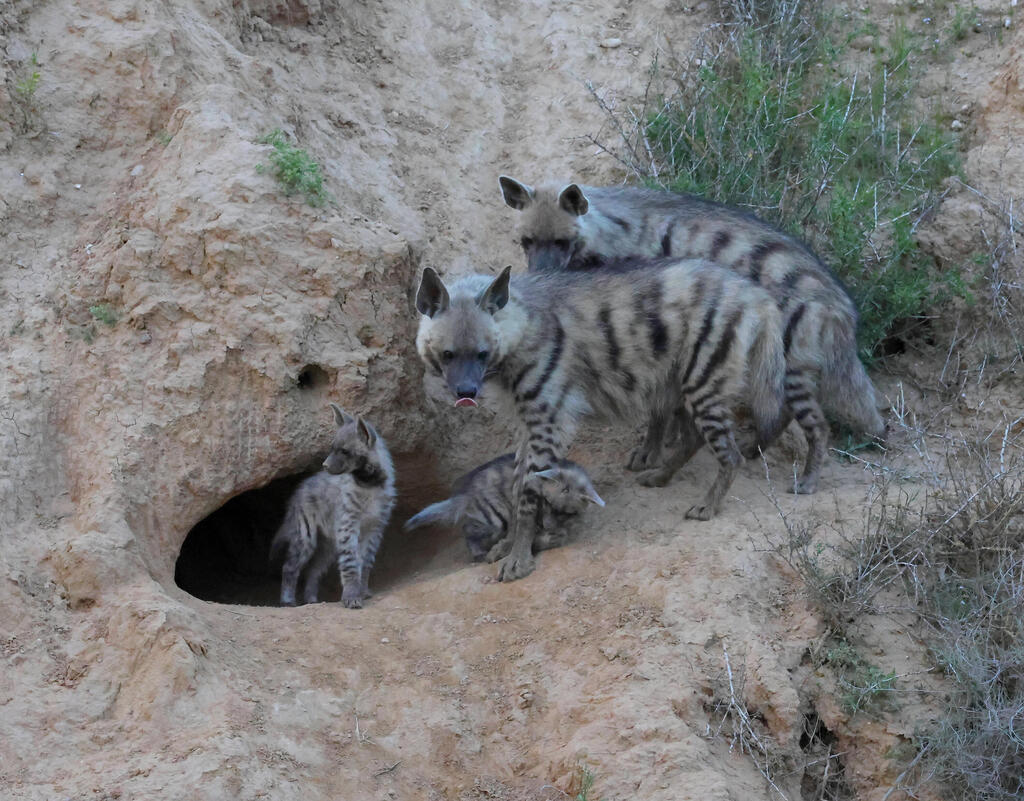

Hyena cubs with their mother and older sister
(Photo: Ezra Hadad, Nature and Parks Authority)
The helping hyenas gained vicarious experience in mothering cubs, even before reaching sexual maturity. "The helpers play, feed and protect the cubs in their den. The cubs play with them and learn social and other skills that will help them survive as adults," Hadad and his colleagues explained in the article.
A growing population
Several hundred hyenas currently live across Israel. In the central part of the country, the population is located near cities, and in certain cases, such as in Modi'in, the city serves as a regular part of a hyena's territory where it enters urban areas to gather food.
Ruthie, a hyena who frequented Modiin trash cans and became a social media sensation, and which was hit by a car and killed a year ago, managed to bring attention to the hyena population in Israel, which is thriving despite the extensive development encroaching on their habitats.
"What amazed me was that I saw and documented the younger hyena leaving the den in the Negev region where the cubs lived," Hadad recalled.
"She would look around, and then go to the nearby wadis, about 400 meters away from the den, to bring the mother to the cubs so she could nurse them. During this time, the older cub would lie down next to them and not interfere at all.”
"Before the cubs reach maturity, they learn how to be a mother from their own mothers. Foxes have a family, and the male guards them and has warning calls. The same goes for jackals. This is not the case with hyenas,” he explains.
“They mate, and the male disappears. I’ve never seen a male arrive at dens where cubs are present. This assistant, the adult cub, is really like a watchdog. In one of the videos, you can hear a jackal's call, and the young babysitter stands with her ears perked up, even more alert than the mother. She sleeps with the cubs, while the mother is in a different den."
The Hyaenidae family is the smallest family among the carnivore order, and consists of only four species, with the striped and brown hyenas being the closest phylogenetically.
Alloparenting has been observed in brown hyenas, where females may nurse each other's cubs, but it is known that they prioritize their own cubs and genetic relatedness determines how well they cooperate.
In contrast, with the striped hyena, the females are solely responsible for caring for their cubs. Hadad's research included dens that were documented throughout central and southern Israel. The helping adult cubs were all cubs born in a previous brood, meaning they were full sisters of the cubs they cared for, and they were at least 10-12 months old.
"This is a project I began," Hadad explained. "The striped hyenas have suffered a terrible injustice. They have been persecuted for generations worldwide, including in Israel. They’re gentle and quiet creatures.”
“I’ve lived with striped hyenas for years. There were situations where they were by my side, and I would sit with them. They have a pleasant smell and clean fur," he said.
Amir Balaban, working for the Society for the Protection of Nature, says that "there was no documentation of such behavior in professional literature or in nature. The striped hyena is a very mysterious creature, and very little is known about its biology and way of life.”
“Thanks to the fact that Israel is a stronghold for striped hyenas, we’re discovering a lot of new information about this animal, its distribution in the country, and its social structure,” he explained.
"Following mine and Ezra’s observations, we discovered female hyenas were active in their dens that included grown-up cubs. Initially, it wasn’t clear why this was happening. But as the observations continued, we understood that these are females that integrate into the cub-rearing process, sisters who accompany the process.”
“This was already observed in spotted hyenas, but it was unknown among striped hyenas,” he explains. “Such a phenomenon indicates an intelligent, relatively developed animal with complex social abilities that, together with its reliance on carrion as a food source, allows it to exist and even thrive in some areas of Israel.”
“Some people view the striped hyena as an unclean animal, but Ezra's research shows that it’s a very unique and clean animal, demonstrating loyalty and very strong family bonds."
Providing mutual support
The researchers observed that the cubs bristle their fur when they’re excited or feel threatened, and also mimic the behavior of their older caretakers.
"We saw a golden jackal approaching the den, and the older hyena bristled her fur, and the three cubs did the same," explains Hadad. "Both the mother and the helper have specific areas where they defecate. The cubs quickly learned to do the same only in those spots.”
"During the day, when the mother is not in the den, the helper plays with the cubs and teaches them survival techniques, such as burying food. In areas with sandy soil, the helper taught the cubs how to dig and remove dirt to enlarge the den.”
“We also saw the helper grinding her teeth against a tree trunk, perhaps to sharpen them or clean them, and the cubs imitated her actions,” he says.
“The helpers play games with the cubs using various objects, such as old shoes, plastic bottles, aluminum drink cans, pieces of plastic pipes and the like. But they also played with bones, skulls and pieces of fur from the food brought to the den by the mother.”
“The games usually involved running in circles with the cubs chasing the helper, accompanied by light biting, pulling of fur, play fighting, and snarling,” he says.
“When the mother is able to bring large amounts of food, she hides the excess under a bush or digs a hole in the ground up to 400 meters away from the den. During the day, the helpers retrieve food from the cache to feed the cubs," Hadad explains.
6 View gallery
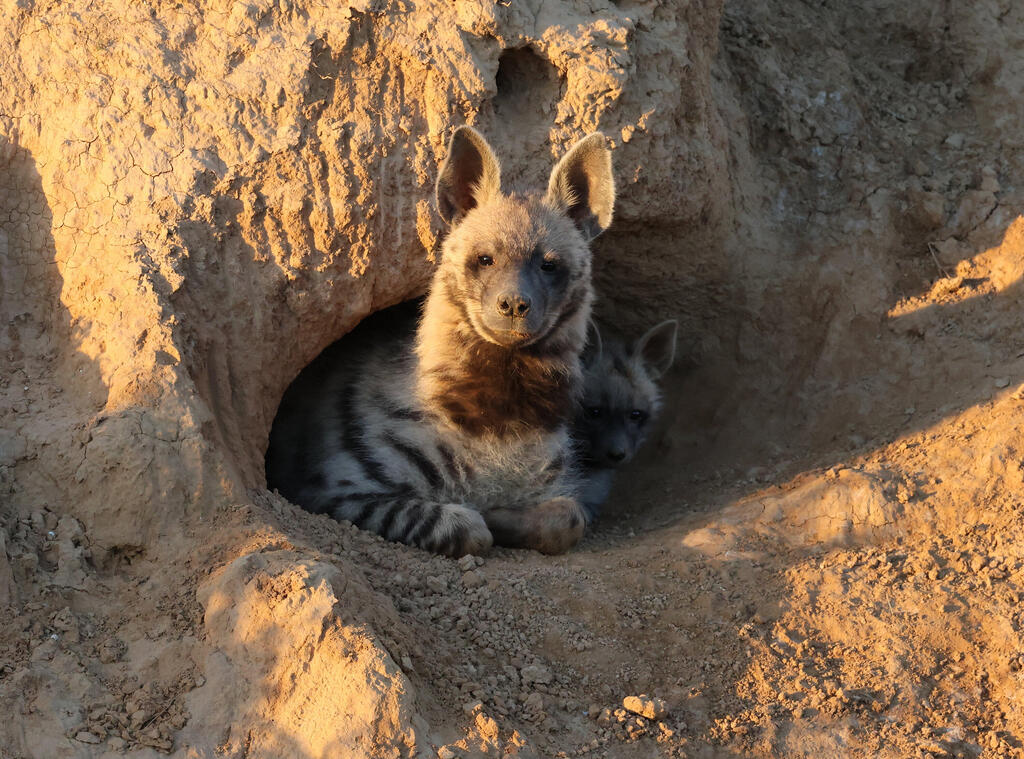

An older female hyena protecting small cubs
(Photo: Ezra Hadad, Nature and Parks Authority)
In most dens, the older cubs regulate the feeding times of the smaller cubs. At a specific time, they leave the den to bring the mother to the cubs. When the mother arrives, the cubs run excitedly toward her and try to suckle.
When the mother and helper meet outside the den, they greet each other by smelling each other. When the cubs leave the den at around the age of one month, they’re accompanied by the helper, without their mother.
"After the cubs grow up, the helper leaves and raises a family with the skills she acquired. It's an excellent experience," says Hadad. "The research demonstrates the insights and benefits that this experience gives to the older female cub," says Yosef. "As well as to the mother, who receives help with caring and protecting her offspring."
Hadad hopes that his research will contribute to the conservation of hyenas in Israel. "Future studies need to understand the reproductive biology of the striped hyena in its natural habitat," he says. "The fact we discovered cooperative breeding in this solitary species suggests that there’s much more to learn about it."




